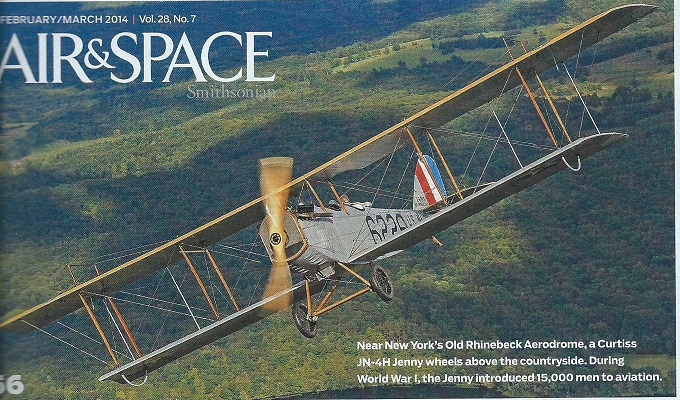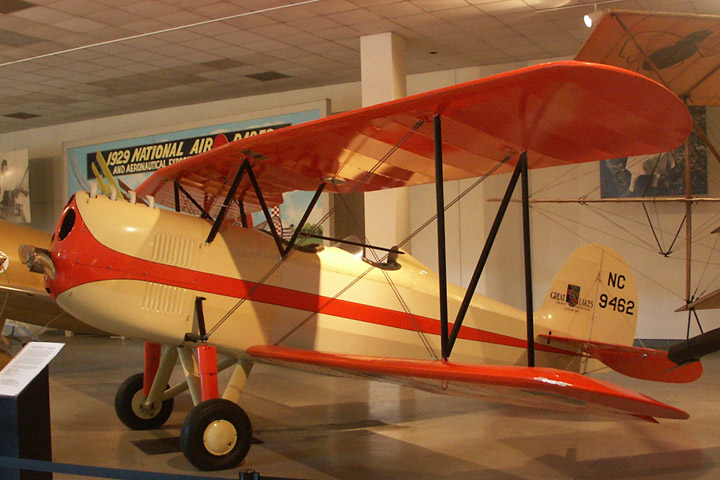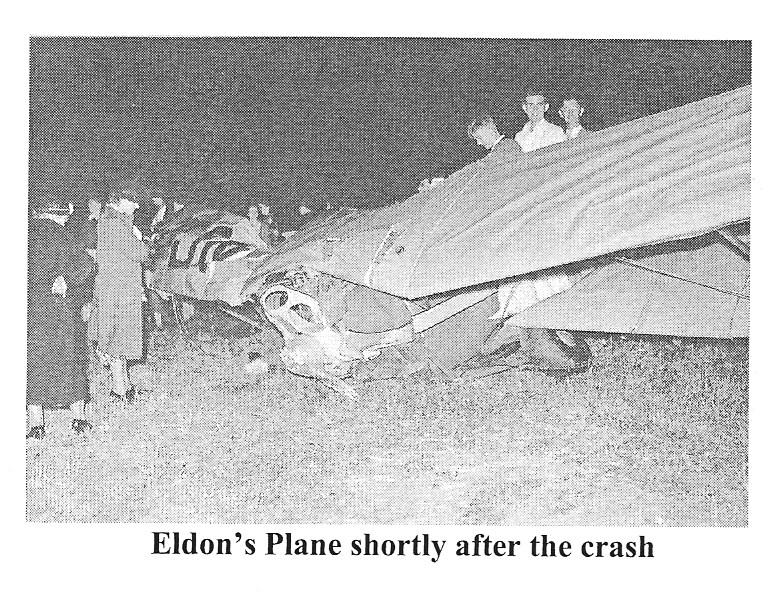
Eldon GEARHART plane crash


An article in the Feb/Mar 2014 issue of 'Air & Space' by Wm Crawford Woods (thx to DBS for sending this to me) discussed the famous Curtiss JN-4 'Jenny' airplane, which was introduced just before WWI and became a primary trainer for pilots. 6800 were made and only 50 survive today, max speed 75mph and max altitude 6500ft, impressive for 1915. He says virtually every American and Canadian pilot sent to the front would have spent time in the Jenny's dual cockpits. The author's Gdad 'painstakingly mastered the demanding ship'. The Jenny is mentioned in an online history of the GLAC (you can find it by searching for 'Great Lakes Sport Trainer') ... its the late 1920s ... Henry Ford retools from Model T to A (Spr 1927, closed 6 mos to Fall) ... prohibition is in effect (1919-32) ... WWI ended 10yrs before [so 1928] ... the Jenny was then the mainstay for 'flying the mail, barnstorming or anything else' WWI pilots could think of to keep flying and make a living ... it could be purchased military surplus for a few 100 dollars but came w/some hard lessons. Its [90hp] OX-5 engine sometimes required special coaxing to cooperate w/the demands of its pilot, and on a good day its performance was dismal ['hi-tech' in 1915, but by then dated]. Adding difficult handling w/an unreliable engine had caused the demise of many Jennies and their pilots. Change was needed [GLAC and others] ... then came Chas Lindbergh's flight to Paris in 'The Spirit of St Louis' (t/o 20 May 1927), which got everyone talking about aviation, planes and pilots 'overnight'.
It was about then that a group of investors from Cleveland and Detroit set up the Great Lakes Aircraft Co in Cleveland by taking over (famous aviation pioneer) Glenn L Martin's facilities there (16,800 St Clair Rd) when GLM moved to Baltimore. GLAC was fnd'd Oct 1928 w/ofcrs Wm Robts Wilson (CoB), Chas F Van Sicklen (VP/Dir sales), Richard Hunter (Dir ads) and P B 'Zeke' Rogers (chf engr). The owner was a (bank) holding co based in Detroit called Allied (Detroit) Motor Industries (no doubt tied to the auto industry there). They were entitled to build any Martin plane and soon delivered 16 of the small bombers the Navy had ordered (Great Lakes BG-1 Divebomber). They also began developing a 2-seat biplane trainer named the '2T'. 1st came the straight-winged 2T-1, then the swept-wing 2T-1A, then the bigger-tailed 2T-1E (and -1MS ...). Its 90hp engine came from American Cirrus (owned by same hldg co). Orders flooded in for ~650 but only 264 airframes were built before the Oct 1929 mkt crash (many orders were then cancelled). The firm struggled, competing w/Grumman for a Navy bomber contract (but losing) in the early 1930s. The firm went bankrupt in 1933, closing in 1936. Interestingly, the 2T airframe became very popular w/private enthusiasts, becoming 'for 30yrs to the late 1960s the top US-made acro[batics] plane' flown by many well-known stunt pilots (Tex Rankin and others, GLAC history, see o/l). Its wingspan was 26' 8" and length 20' 4". Rights to the design were bot by Harvey Swack and he sold plans to hobbyists til the late 1960s. In the 1970s GLAC was revived and 137 more airframes were built in CO? (w/another 6 in GA). And a modified version is still on offer today as GLAC is owned by John Duncan of Parker, CO. I think the 2T below is like the one Eldon crashed (scan crash pic). The pic was labelled 2T-1 (tho it has a swept-wing), and the museum website called it a 2T-1A (tho it has a bigger tail), so I think its a 2T-1E. It has the same color-scheme as Eldon's except maybe the colors are reversed (Eldon's had a lighter stripe on a darker background).


Eldon's crash site, scanned from Wanda's JiF Vol. 2
Eldon D. Gearhart, 31, Altoona, the student flyer, died in the receiving room at Mary M. Packer hospital here a few minutes after admittance. His forehead was badly crushed, the left ankle broken and his face and one eye lacerated. Reports that every bone in his body was fractured were denied by examining physicians.
George "Jack" Spaid, 29, Selinsgrove, the instructor-pilot, is a patient at Geisinger hospital, Danville. He was described today as "pretty good," and Dr. H. L. Foss, chief of the hospital staff, said definitely he would recover unless unforeseen complications develop. Spaid sustained a compound fracture of the right leg, a possible fracture of the left leg, a severe injury to the upper jaw, lacerations of the face and head and numerous body bruises. A half dozen teeth were knocked out. Following a blood transfusion last night he took a sudden turn for the better and apparently is out of danger.
The accident occurred in an open field on the farm of Dennis Conrad, atop Boyer's Hill, which is 6 miles below the city and about 3 miles to the west of the Sunbury-Herndon highway.
The ship, a Great Lakes Trainer, was totally ruined with exception of the rear part of the fusilage.
Gearhart and Spaid had taken off from the Sudbury Airport only a few minutes before. They headed due south over the six-mile stretch and in Spaid's own words he told Gearhart to turn around and head back.
The student flyer started to make the bank and negotiated it successfully. It was explained that in making a turn, a plane's speed is necessarily reduced and the slower pace causes it to "nose down" to the ground.
Gearhart knew this, and following common flying sense pulled the stick back, to bring it to an even keel. He evidently became confused for the ship nosed up toward the sky.
Spaid, cognizant of the fact that all was not going well, called to his companion to "level it off." In his confusion, Gearhart instead of pushing the stick forward again, pulled it back still further and held it in a death-like grip.
Spaid grabbed his control stick and would have been able to avoid the accident had the other man released his hold. As it was they battled until the craft got completely out of control and careened dizzily to the ground, landing with a thud in the field.
Experienced flyers explained that it "mushed in," pointing out that the ship did not come down directly on its nose, but on an angle sufficient to have it tilt over, although the front actually did bear the brunt of the fall.
Eye-witnesses of the plunge said that the ship whirled around three times in the air before striking the ground. It seemed to fall "slow" one person said, the wings circling from the fusilage which remained almost vertical while turning.
It is estimated that the craft fell at a speed of well over 70 miles an hour, despite the fact that observers thought it came down "slow." The nose dug a hole nearly a foot deep when it contacted. The craft bounced backwards fully 10 feet, struck the earth a second time and then lunged forward five feet before coming to a complete stop. It turned completely around after the first contact.
The four-cylinder motor was pushed back dangerously close to the cockpit, where Spaid sat. The propeller was broken in many pieces, both wings crumpled, the undercarriage demolished and the front portion of the fusilage pushed back like an accordian.
Morgan Herr, York, the owner, said he believed the motor could be salvaged. He was skeptical about the remainder. The wreckage was to be removed from the scene to the Sunbury airport today.
John A. Abiuso, Sunbury airport manager, had taken Gearhart up for one lesson but the Altoona man was not satisfied. Abiuso could not meet his demand for further flying time, however, having other students awaiting instruction, so he suggested that Gearhart arrange with Herr to fly the Great Lakes Trainer, and that Spaid, a licensed pilot, accompany him.
It was a "rough" flying day. There was a 25 MPH wind and many "air pockets."
Gearhart ran to the upper end of the airport and made a graceful take-off. They headed south, with the strong wind at their tail.
Gearhart was in the rear cockpit of the two-seater open-type ship, with Spaid in the front. Both had access to a control stick, although Spaid's was there for use only in case of emergency.
Student flyers customarily take a tighter grip on the stick on a "rough" day, and such was Gearhart's case. Both Abiuso, who first had him up, and later Spaid, had warned him to "fly easy."
The fact that Spaid was fortunate enough to escape death in the front cockpit, where most of the concussion came, was considered nothing short of miraculous.
Both men were pinned in their seats. Spaid was extricated without a great deal of difficulty but it took fully ten minutes to get Gearhart out. He was unconscious and limp and his left leg was held fast beneath the dash.
Spaid was conscious from the time neighboring farmers first arrived at the scene. They placed him on the ground and leaning on one elbow, he directed the efforts to get Gearhart out.
Enroute to this city to be placed in the Americus Ambulance for removal to the hospital, he told a straight-forward story of the accident and made the request that his wife be notified by telephone. "and be sure and tell her that I'm alright."
With great pluck, he pulled from his mouth several teeth that had been knocked loose in the crash and threw them from the window of the automobile.
